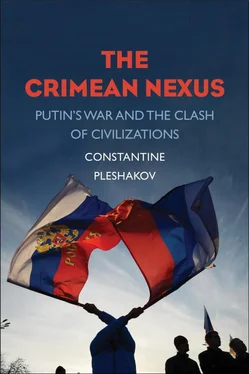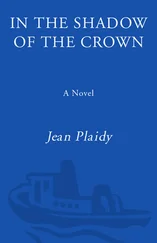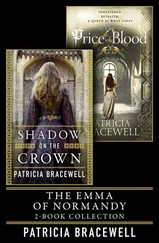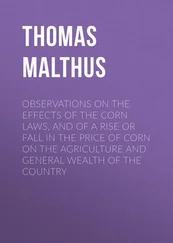Khan Shagin Giray, whom she supported in Bakhchisaray, saw himself as a Crimean Peter the Great—a modernizer who would borrow technology and governmental structures from Europe. Catherine returned the littoral to the khanate and took care of its bursary. As an attempt at social engineering, Catherine’s Crimean project anticipated later Western efforts in the non-Western world. While its stated good intentions, such as social reform and modernization, are impossible to prove or disprove, the pragmatism of the strategy is as valid now as it was in Catherine’s day: to raise a junior ally whose new (Westernized) elites would be completely dependent on the creator. [31] Montefiore, Potemkin , 246–247.
And not unlike the twenty-first-century attempts at nation-building, Catherine’s Crimea project collapsed. The experiment had a bloody ending—civil war—unsurprisingly so because the khan was rightly seen as a puppet of an alien power. In 1783, Russia squashed the rebellion and annexed Crimea.
Catherine dismissed the failed experiment in Crimea as a freak loss, still sure that the Greek monarchy and Dacia would succeed. To demonstrate her commitment to the development of the conquered Ottoman lands and to celebrate her victory in the clash of civilizations, in 1787 she put herself through the terrible inconvenience of visiting Crimea in person, with European ambassadors and the emperor of Austria in tow.
The six-month journey proved monumental, belonging among the top PR campaigns in history. Catherine was delighted by what she saw and proclaimed Crimea the “Garden of Eden.” Having failed to engineer change on the peninsula through its government, she now launched a massive campaign of colonization. [32] Ibid., 363–381; Henri Troyat, Catherine the Great (New York: Meridian, 1994), 272–288. Primary sources include Louis Philippe Ségur, Mémoires, ou souvenirs et anecdotes (Paris, 1827) and The Prince de Ligne: His Memoirs, Letters, and Miscellaneous Papers (New York: Brentano’s, 1899).
Catherine reimagined Crimea as a Russian Greece to exist alongside Moscow, the Third Rome. The territories of the khanate were divided into three provinces: Kherson and Yekaterinoslav on the mainland steppe, and Taurida as the Crimean peninsula per se. The name Taurida reflected Catherine’s Greek pretensions for the place, as did the names of two major cities she started on the peninsula—Sevastopol and Simferopol. Kaffa and Goezleve had their ancient Greek names restored: Feodosia and Yevpatoria, respectively.
Tellingly, the rest of the toponyms were kept Turkic, with su for “river,” dahg for “mountain,” and gol for “lake.” Catherine ruled by corruption, not coercion. Tatar nobles were given Russian nobility, land grants, and power over the previously free peasantry. With the aristocracy thus brought over to her side, revolts on the peninsula remained few and insignificant. Catherine also brought in new settlers: the steppes had hardly any tradition of agriculture.
Although international trade was considerable (the port of Yevpatoria alone received 170 foreign ships a year), the peninsula’s export-import structure did not look satisfactory. Crimea exported salt from the Perekop marshes, wool, and sheepskin—both products of semi-nomadic Tatar shepherds. From the Mediterranean, it imported silk and cotton cloth, wine, lemons, oranges, chestnuts, olives, apples, dates, coffee, and tobacco. From mainland Russia, wheat, butter, and linen came, and also one telling item, locks, exceeding eighteen thousand a year—clear evidence of the redistribution of property. Importing items like oranges and coffee was unavoidable, but the Garden of Eden was certainly capable of producing more domestically. The list the colonizers came up with included wheat, wine, silk, raisins, almonds, figs, prunes, olives, capers, herring, anchovies, and oysters. Having little regard for Russian and Ukrainian peasantry, the empress invited farmers from abroad, starting with her home country, Germany. [33] Pavel I. Sumarokov, Dosugi krymskogo sud’yi ili Vtoroe puteshestvie v Tavridu (St. Petersburg: Imperatorskaya Tipografiya, 1803), 130–131, 171–179; Williams, The Crimean Tatars , 83.
Within two decades, Crimea’s South Shore became popular with the imperial aristocracy. Some built summer retreats, others moved to the littoral permanently—a quaint community consisting of devoted agriculturalists excited by the opportunities the subtropical climate offered, retirees disenchanted with the metropolitan glamour, spiritualists seeking seclusion, and former courtiers marred by scandal. [34] N. S. Vsevolozhskii, Puteshestvie, chrez yuzhnuyu Rossiyu, Krym i Odessu, v Konstantinopol, Maluyu Aziyu, Severnuyu Afriku, Maltu, Sitsiliyu, Italiyu, yuzhnuyu Frantsiyu i Parizh v 1836 i 1837 godakh (Moscow: Avgust Semyon, 1839), 59–79.
Mary Holderness, an intrepid British traveler who spent four years in the village of Karagoz in eastern Crimea between 1816 and 1820, left a detailed account of her sojourn on the peninsula. I am unable to find a good explanation for why a British woman would move to a very basic settlement in the wooded hills, easily a day’s journey from the nearest town. But others did the same thing; something about Crimea appealed to restive spirits, the kind of people who in later centuries would move to Tangier or Bali.
Mary Holderness caught Crimean diversity at its peak: all the people of the khanate were still there, and the government’s resettlement campaign had added newcomers. In the towns of Crimea, Holderness reported, one could find the “descendants of more than fifteen different nations.” [35] Mary Holderness, Journey from Riga to the Crimea: With Some Accounts of the Manners and Customs of the Colonists of New Russia (London: Sherwood, Gilbert and Piper, 1827), 216.
Like most travelers, Holderness had carried her prejudices with her and brought them back home unchanged; the classification of Crimeans she suggests tells us at least as much about a colonizer’s mindset as about the people she was observing.
She found the “habits and modes of agriculture” of the Tatars “rude and simple,” their wealth still consisting “in flocks and herds.” The Nogai Tatars, she thought, had fared especially poorly, despite the Russian government’s efforts to conquer the “inveterate prejudices of this wandering horde” and induce them to take up farming. “They are, however, of all the colonists, far the worst cultivators; and are still much addicted to grazing large flocks and herds, and numerous studs of mares.” [36] Ibid., 141, 217, 270.
According to Holderness, the largest minorities were Greeks and Germans, each constituting about 10 percent of the population. “The occupations of the Greeks are perhaps more various than those of most of the settlers. In the towns they are found as respectable merchants, as small shopkeepers. …The Greeks also are the only fishers who adventure far for the purpose of fishing.” [37] Ibid., 145.
The German Mennonites, or Moravians, in the steppes “came over with plenty of money, knowledge of business, and superior industry, and are at present a wealthy race; having built large farm-houses and offices, planted extensive orchards, and laid out great gardens, possessing the finest breed of cows in the country, and growing a great abundance of corn.” But a different group of Germans, the Swabians, she found low and brutal in their manners, “the least civilized inhabitants of the Crimea.” [38] Ibid., 160–162.
“The Bulgarians, though ranking low in point of numbers amongst the other colonists of New Russia, are perhaps deserving the first notice, from the high character they bear, as a sober, industrious, and meritorious class. …As agriculturalists, the Bulgarians hold also pre-eminence amongst their neighbours.”
Читать дальше












